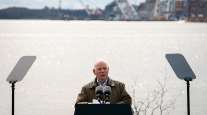Virginia Says P3 Partnerships are Working, and the State Wants More

In a conference here at George Mason University during Infrastructure Week, policymakers from Virginia and beyond said privately arranged debt, equity and work form an essential part of transportation systems, especially when legislators and voters are highly disinclined to raise taxes. Virginia’s Legislature authorized public-private partnerships for transportation in 1995.
A Pennsylvania transportation official also said his state has been doing P3s for just three years, but that the device was used for bridge repairs.
Regarding I-66, which links Washington with Interstate 81 near Front Royal, Virginia, the state’s transportation secretary, Aubrey Layne Jr., told his audience at Mason’s public policy school, “The Commonwealth wants a partner on [I-66].”
Layne, serving as secretary since January 2014 and appointed by Gov. Terry McAuliffe, said that “in order to deliver our transportation program, we must have public-private partnerships.”
One of the state’s main highway P3s is the network of tolled express lanes in and around the Capital Beltway, or I-495.
In Pennsylvania, the state bundled together bridge projects, said Dale Witmer, deputy director of the P3 office in the state transportation department.
The Keystone State has 6,000 structurally deficient bridges and was adding 400 per year to the list, Witmer said. PennDOT bundled the projects together and had private firms do all of the work: design, build, finance, maintain and operate.
Witmer said the consolidation led to savings through economies of scale, and the private partners get paid as the repaired bridges become available. The state will not toll the bridges, but is using a variety of state tax funds instead.




